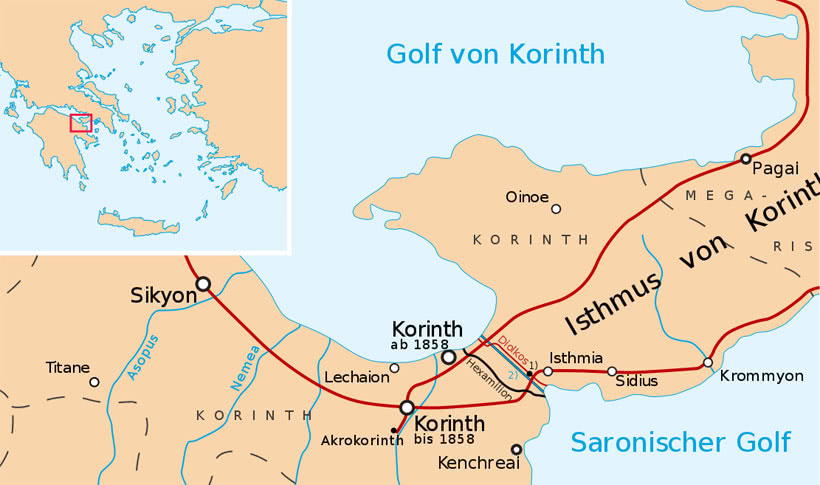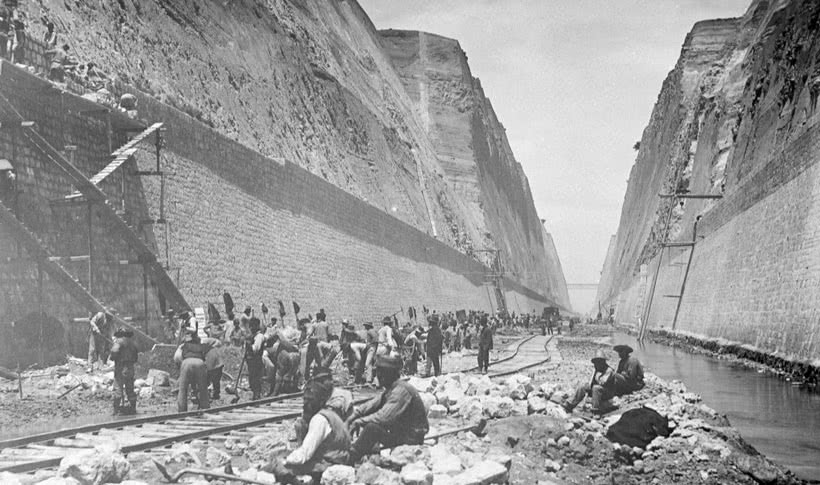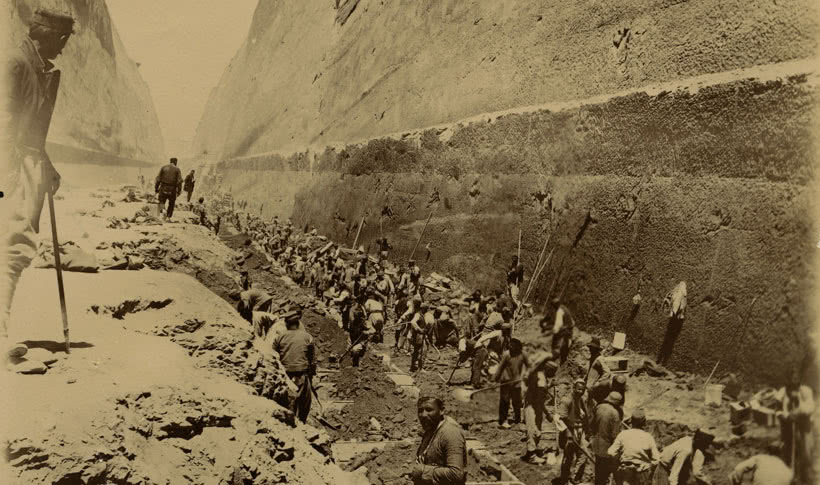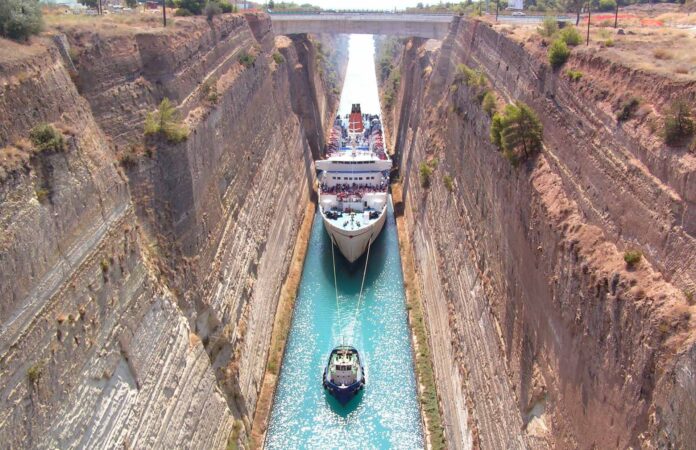[Reading level: C1 – Advanced]
The Peloponnese Peninsula and the Greek mainland meet at the Isthmus of Corinth. Already in the 6th century B.C., engineers thought that this isthmus, with a width of approximately 6km, would be the ideal place to build an artificial waterway connecting the Gulf of Corinth with the Saronic Gulf. Such a canal would spare sailors the almost 400km long detour around the entire Peloponnese, which was just as difficult as it was treacherous.
There are countless technological masterpieces from ancient Greece, yet this project would prove to be unattainable for the Greeks, Romans, and even the Venetians: the construction of the Corinth Canal, which had been a dream of the ancient Greeks for thousands of years, would only be realised in the modern area, between 1891 and 1893. So why did it take so long for a 2,500-year-old dream to become a reality?

A project with many obstacles to overcome
Sea routes in ancient times were fraught with danger: without an engine, sailors were unprotected from the elements and rough seas. During antiquity and the Middle Ages, most ships travelling from Europe to Asia or vice versa, sailed to the Isthmus of Corinth. This way they were able to avoid the detour around the Peloponnese and sailing through the open Ionian and Aegean seas, with all the dangers this entailed. On arrival at the isthmus, the ships were completely unloaded, then pulled across the isthmus by the Corinthians using countless ropes and tree trunks on a ship’s trackway called “Diolkos”. Once on the other side, the ships were loaded once more and could continue their voyage. This tedious procedure took several days and laid the foundation for the former wealth of Corinth as a trading power.
It is therefore not surprising that the idea of building such a canal is one that is thousands of years old. The Corinth Canal was an incredibly challenging project with numerous obstacles, which resulted in even the greatest political leaders of the antiquity failing to see it through.
The idea for a canal originated with Periander, the second tyrant of the Cypselid and ruler of Corinth, in the 6th century BC. However, seemingly without any attempted construction, the project was abandoned. In 40 A.D., the Roman emperor Caligula sent engineers to the isthmus to take necessary, concrete measurements for a canal. The engineers returned with devastating results: they feared that the sea level of the Ionian Sea (Gulf of Corinth) was higher than that of the Aegean Sea (Saronic Gulf) and that creating a gap through the Isthmus of Corinth could cause the flooding of Aegina Island and possibly also of the city of Athens.
Though, as we know today, this was a mistaken assumption, and did not deter the Roman emperor Nero from beginning a larger-scale construction project. It is said that in 67 A.D. the emperor himself broke ground with a golden spade, before leaving the remaining work to 6,000 slaves. However, Nero died shortly afterwards, and construction was stopped.
The project remained dormant until the 17th century, when members of the Venetian fleet again began digging a canal at the Isthmus of Corinth. However, they too quickly encountered solid rock and were forced to abandon the project.
The miracle cure that was to make the construction of the canal possible was the 19th century innovation, dynamite, a revolutionary explosive, invented in 1867 by Alfred Nobel. With the help of dynamite, incredibly careful planning and numerous workers, the construction of the canal was finally accomplished in a record time of less than three years. The two Hungarian engineers Istvan Türr and Bela Gerster, were the ones to finally succeeded in the construction of the Corinth Canal, 2,500 years after the idea was first conceived.

Miracle of the modern age – what makes the Corinth Canal so unique
Fascination with the Corinth Canal has remained from its conception until this very day. Every year countless tourists visit the Isthmus of Corinth to see this technological marvel with their own eyes. If you stand on one of the five bridges spanning the canal and look down at the steep rock face and water below, you will immediately see what an incredible achievement the construction of this canal is.
The rock-cut walls of the 6.3 km long canal rise to 84 m – a hugely impressive sight. The canal has a conical shape, being considerably narrower at the bottom than at the top: The width at the bottom is only 21 m, increasing to 24m at the water surface and 75 m at the top.
In order to transport the unbelievable masses of rock out of the canal during the construction, a railway line was built at the bottom of the canal. Of course, water now flows through the entire canal, though only 8 m in depth. At both ends of the canal there are subversive traffic bridges that sink into the water to allow vessels to pass.
As the canal is so narrow, it only allows ship traffic to pass through in one direction at a time. The entrance is controlled by the Isthmus Port Authority by way of a traffic light. The passage usually takes half an hour. For very large ships that have to be towed, it can take up to an hour and a half.
Environmental factors have made the steeply rising rock faces of the canal deteriorate, and sand is constantly falling into the artificial waterway. The canal therefore requires permanent maintenance. This, together with high construction costs, is responsible for the fee of passage: €10 per ship meter is charged and must be paid at the harbour office of the Saronic Gulf.

Significance of the Corinth Canal – then and now
Historians agree; without the Corinth Canal, Central Greece would be a different place today. Its construction was responsible for the emergence of the port of Piraeus as one of the most important trading ports in the Mediterranean. Thus, the canal is likely to have had a considerable influence on the size of the city of Athens today.
However, due to the further developments in shipping, the canal has long since lost its former importance. It is nevertheless still a thriving tourist attraction, which is responsible for the relatively high volume of traffic through the canal. To date, an average of 30 ships pass through the canal every day, which corresponds to around 11,000 ships per year.
Surprisingly, passage is still not simple for tourists, so most travellers have to be content with an – admittedly very impressive – panoramic view of the canal from one of the bridges above. However, this hardly replaces the incredible feeling of sailing through the Corinth Canal by boat.
If you have a sailing licence, you’re off the hook and can cross the Corinth canal by sailing boat. Some cruise lines also offer the passage through the Corinth Canal, such as Olsen Cruise Lines or Nicko Cruises. If you are looking for something more exclusive, you can also enjoy this unique experience with Islandhopping. The charming motor vessel, Panagiota, sails through the Corinth Canal several times a year on the Bike & Boat tour through Ionian Islands and the Gulf of Corinth. The same operator also offers an e-bike and boat tour from Athens to Lefkada, which also passes through the legendary canal.

Source: https://www.inselhuepfen.com/en/blog/detail/the-corinth-canal
WORD BANK:
peninsula /pəˈnɪn.sə.lə/ [B1] (n): bán đảo
isthmus /ˈɪs.məs/ [C1] (n): eo đất
artificial /ˌɑːr.t̬əˈfɪʃ.əl/ [B2] (adj): nhân tạo
gulf /ɡʌlf/ [B2] (n): vịnh
canal /kəˈnæl/ [B1] (n): con kênh
spare sb sth /sper/ (v): giúp ai tránh được cái gì (thường là tránh điều không mong muốn)
detour /ˈdiː.tʊr/ [B2] (n): đường vòng
treacherous /ˈtretʃ.ɚ.əs/ [C1] (adj): nguy hiểm (vì thời tiết, địa hình…)
countless /ˈkaʊnt.ləs/ [B2] (adj): vô số
masterpiece /ˈmæs.tɚ.piːs/ [B2] (n): kiệt tác
unattainable /ˌʌn.əˈteɪ.nə.bəl/ (adj): ngoài tầm với
sea route /ˈsiː ruːt/ (n): tuyến đường biển
fraught with sth /frɑːt/ [C1] (adj): đầy rẫy
the elements /ˈel.ə.mənts/ (n): thời tiết khắc nghiệt
rough seas /rʌf siːz/ (n): sóng dữ
antiquity /ænˈtɪk.wə.t̬i/ [C1] (n): thời cổ đại
or/and vice versa /ˌvaɪs ˈvɝː.sə/ [B2] (adv): hoặc/và ngược lại
entail sth /ɪnˈteɪl/ [C1] (v): kéo theo cái gì
voyage /ˈvɔɪ.ɪdʒ/ [B2] (n): hành trình (bằng đường biển/không gian)
tedious /ˈtiː.di.əs/ [C1] (adj): tẻ nhạt
procedure /prəˈsiː.dʒɚ/ [B2] (n): quy trình
laid the foundation for sth /leɪ daʊn/ (v): đặt nền móng cho cái gì
obstacle /ˈɑːb.stə.kəl/ [B2] (n): trở ngại
fail to do sth /feɪl/ [A2] (v): không thể làm gì
see sth through /siː θruː/ [C1] (v): hoàn thành cái gì đó
tyrant /ˈtaɪ.rənt/ [C1] (n): tên bạo chúa
ruler /ˈruː.lɚ/ [B2] (n): người cai trị
abandon sth /əˈbæn.dən/ [B2] (v): từ bỏ cái gì
emperor /ˈem.pɚ.ɚ/ [B1] (n): hoàng đế
concrete /ˈkɑːn.kriːt/ [B2] (adj): cụ thể
devastating /ˈdev.ə.steɪ.t̬ɪŋ/ [C1] (adj): gây tàn phá
gap /ɡæp/ [B2] (n): khe hở
mistaken /mɪˈsteɪ.kən/ [B2] (adj): sai lầm
assumption /əˈsʌmp.ʃən/ [B2] (n): giả định
deter sb from doing sth /dɪˈtɝː/ [C1] (v): ngăn ai làm gì
break ground /breɪk ɡraʊnd/ (v): khởi công
spade /speɪd/ (n): xẻng
slave /sleɪv/ [B1] (n): nô lệ
shortly afterwards /ˈʃɔːrt.li ˈæf.tɚ.wɚdz/ [B2] (adv): không lâu sau đó
dormant /ˈdɔːr.mənt/ [C1] (adj): bất động
fleet /fliːt/ [B2] (n): hạm đội
encounter sth /ɪnˈkaʊn.t̬ɚ/ [C1] (v): gặp phải cái gì
miracle /ˈmɪr.ə.kəl/ [B2] (n): phép màu
revolutionary /ˌrev.əˈluː.ʃən.er.i/ [C1] (adj): mang tính cách mạng
explosive /ɪkˈsploʊ.sɪv/ [B2] (n): chất nổ
accomplish sth /əˈkɑːm.plɪʃ/ [B2] (v): hoàn thành cái gì
conceive sth /kənˈsiːv/ [C1] (v): hình dung, nghĩ ra
see sth with one’s own eyes /siː/ (v): tận mắt chứng kiến
technological marvel /ˌtek.nəˈlɑː.dʒɪ.kəl ˈmɑːr.vəl/ (n): kỳ quan công nghệ
span sth /spæn/ [C1] (v): kéo dài, bắc qua
hugely impressive /ˈhjuːdʒ.li ɪmˈpres.ɪv/ (adj): vô cùng ấn tượng
conical /ˈkɑː.nɪ.kəl/ (adj): hình nón
masses /ˈmæs.ɪz/ [B2] (n): đám đông, quần chúng
subversive /səbˈvɝː.sɪv/ (adj): chìm, ngầm
tow /toʊ/ (v): kéo
deteriorate /dɪˈtɪr.i.ə.reɪt/ [C1] (v): xuống cấp, tệ đi
emergence /ɪˈmɝː.dʒəns/ [C1] (n): sự trỗi dậy
thriving /ˈθraɪ.vɪŋ/ [C1] (adj): phát triển mạnh
relatively /ˈrel.ə.t̬ɪv.li/ [B2] (adv): tương đối
correspond to sth /ˌkɔːr.əˈspɑːnd/ [B2] (v): tương đương với cái gì
content with sth /kənˈtent/ [B2] (adj): hài lòng với điều gì
admittedly /ədˈmɪt̬.ɪd.li/ [C1] (adv): phải thừa nhận
panoramic view /ˌpæn.əˈræm.ɪk vjuː/ (n): khung cảnh toàn cảnh
incredible /ɪnˈkred.ə.bəl/ [B1] (adj): tuyệt vời
off the hook /ˌɔːf ðə ˈhʊk/ (idiom): thoát khỏi trách nhiệm/khó khăn
cruise /kruːz/ [B1] (n): du thuyền
exclusive /ɪkˈskluː.sɪv/ [B2] (adj): độc quyền, dành riêng
legendary /ˈledʒ.ən.der.i/ [B2] (adj): huyền thoại
ỦNG HỘ READ TO LEAD!
Chào bạn! Có thể bạn chưa biết, Read to Lead là một trang giáo dục phi lợi nhuận với mục đích góp phần phát triển cộng đồng người học tiếng Anh tại Việt Nam. Chúng tôi không yêu cầu người đọc phải trả bất kỳ chi phí nào để sử dụng các sản phẩm của mình để mọi người đều có cơ hội học tập tốt hơn. Tuy nhiên, nếu bạn có thể, chúng tôi mong nhận được sự hỗ trợ tài chính từ bạn để duy trì hoạt động của trang và phát triển các sản phẩm mới.
Bạn có thể ủng hộ chúng tôi qua 1 trong 2 cách dưới đây.
– Cách 1: Chuyển tiền qua tài khoản Momo.
Số điện thoại 0947.886.865 (Chủ tài khoản: Nguyễn Tiến Trung)
Nội dung chuyển tiền: Ủng hộ Read to Lead
hoặc
– Cách 2: Chuyển tiền qua tài khoản ngân hàng.
Ngân hàng VIB chi nhánh Hải Phòng
Số tài khoản: 012704060048394 (Chủ tài khoản: Nguyễn Tiến Trung)
Nội dung chuyển tiền: Ủng hộ Read to Lead
Lớp luyện thi IELTS online
Bạn đang có nhu cầu thi chứng chỉ IELTS cho đầu vào đại học, đi du học, xin việc hay xin cư trú và đang phân vân chưa biết học ở đâu?
Nếu bạn đang tìm kiếm dịch vụ luyện thi IELTS online với giáo viên uy tín và chất lượng, cũng như học phí phải chăng, thì thầy Trung và Cô Thủy (Admin và dịch giả chính của Read to Lead) có thể là một lựa chọn phù hợp dành cho bạn.
Hãy liên hệ (nhắn tin) tới trang Facebook cá nhân của mình (https://www.facebook.com/nguyen.trung.509) để tìm hiểu về lớp học và được tư vấn cũng như được học thử nha!





